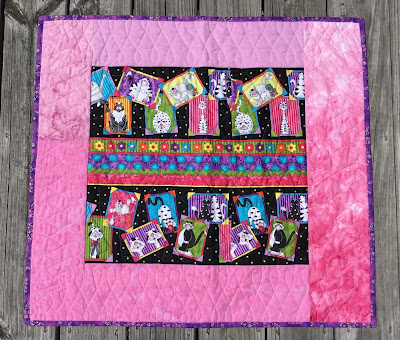 |
| Kumebukuro with Birdie fabric by Mia Charro for Blend Fabrics. |
The traditional Japanese rice bag—kome (rice) and bukuro (bag)—was used to store and carry rice for offerings at Japanese temples. Since I'm back to working on my Glorious Hexagon EPP [English paper piecing] project, I'll likely use my new Japanese rice bag to hold these supplies and blocks.
Materials
This was the plan:
- I wanted to feature these adorable birds from the Birdie collection by Mia Charro for Blend Fabrics on the bag. (Fabric purchased at Chattanooga Sewing Machines)
- I also uncovered a pile of half-square triangles [HSTs] in my stash. The colors worked and it was a repurposing effort.
 |
| Birdie from Blend Fabrics and miscellaneous HSTs. |
- Coordinating fabrics for the outside, lining, and drawstring tabs include two colorways of Forme from Lewis & Irene (fabric purchased at The Quilting Squares of Franklin) and a light blue blender from Basically Hugs by Helen Stubbings for P&B Textiles. (Fabric purchased at Stitchers Garden)
- The drawstring ties were 1" wide lengths of a knit fabric from Art Gallery Fabrics.
 |
| Coordinating fabrics: Forme from Lewis and Irene and Basically Hugs from P&B Textiles. |
- To give stability to the bag, I decided to try a new-to-me product, cork fabric. I received some cut-offs from Midwest Textiles to experiment with.
 |
| Cork fabric from Midwest Textiles. |
The komebukuro is basically a cube. The sides and bottom are all squares so with this formula, the bag can be made any size. My square was 11". The birds and HSTs were framed to build out the square to 11 inches.
 |
| Construction of the sides of the bag. |
At the base of each side panel was a piece of cork fabric. The bottom of the bag was also cork.
 |
| Press the seams of the cork with a seam roller or wooden iron. |
Working with Cork fabric
The cork fabric cuts and sews just like fabric, but don't use a hot iron on this fabric or it will buckle. I used a seam roller to "press" any seams. A wooden iron or finger pressing would also work. I used the regular 80/20 sewing machine needle, 50 wt. cotton sewing thread and my quarter-inch presser foot to sew the cork. It was like working with a heavy weight fabric, but with no stretch.
If I had my druthers
Now that my komebukuro is completed, here are my observations and a few things I will consider for next time:
- The bag does not stand up by itself. (It's kinda slouchy.)
- Although the cork fabric provides a flat base and stability at the bag's bottom, the sides need hand stitching, quilting or interfacing for more support for this size bag.
 |
| This is a slouchy bag. |
- The size and number of tabs for the drawstring allow varying degrees of closure. I would try tabs of a narrower width so the bag closes more.
- Drawstring tabs from cork fabric might be an option. They would be fast and easy—no need to topstitch, no raw edges to fold under, etc.
 |
| Completed Birdie komebukuro with a cork fabric bottom. |
- The design of these bags is simple and elegant, offering a wonderful canvas for patchwork, hand stitching (kantha, embroidery, sashiko), free-motion and machine quilting. Possibilities for surface design abound.
- Pockets could easily be added to the inside—or outside—of this bag!
- I'd like to try different materials for the drawstring... and include decorative finials.
- It would also be fun to make an accompanying little needle book with a cork fabric cover. (Do I hear you saying, "Good idea for a gift"?)
 |
| Close-up of the cardinal Birdie block and HST patchwork. |
I love the Birdie squares on my komebukuro! They are cheerful, bright and make me smile. This bag was a good project to experiment and learn about working with cork fabric, and the opportunity to repurpose a batch of leftover HSTs is very satisfying.
Besides... one can't have too many project bags, right?















































